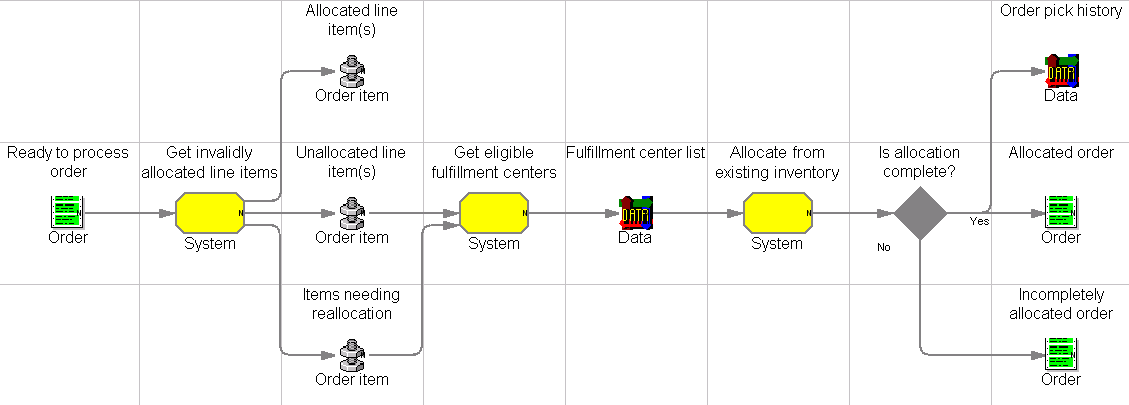Process: Allocate inventory
Flow

Objective
Allocate inventory to an order, thereby reserving it for the order and making the inventory on hand reflect the amount available to new orders.
Description
This process is for ATP inventory only. Available inventory is determined by examining all receipts for an item that are available to a given store and taking into account any inventory that has been reserved (for an auction or any other purpose) or allocated to a backorder. This process takes an order as input. The output of the process is either an order with all its order line items allocated (completely allocated order) or an order that has one or more order line items that are not allocated (incompletely allocated order). The process only allocates order line items that require allocation. They will fall into two categories -- unallocated order line items and order line items needing reallocation. Order line items needing reallocation are those that have had a change in quantity, ship-to address, or fulfillment center. For each order line item needing allocation, the eligible fulfillment centers for fulfilling the item are obtained. This list is processed from first to last by searching for a fulfillment center that has a sufficient quantity available to allocate to the item. The first one found is used. If there is insufficient inventory at a fulfillment center to completely satisfy the request, it may be fully allocated using more than one fulfillment center or it may be partially allocated.
Partial allocation is not allowed for order line items that are currently backordered.
This process supports real-time inventory tracking, allowing product availability to be shown to customers. The process also supports inventory management by updating the amount of inventory in process, which means that it has been allocated but it has not been released to fulfillment.
Features
Availability to promise
Backorder support
- Not backorderable
- Force backorder
Expected inventory
Allocation across fulfillment centers
Customization
- Customized fulfillment-center selection algorithm
- Different picking algorithms
- Automatic order-splitting logic
- Integration with back-end inventory tracking and allocation system
Edition
Professional, Enterprise
Tasks
| Task | Description | Role |
|---|---|---|
| Allocate from existing inventory |
Allocate existing inventory for a particular order item at a particular fulfillment center. The behavior of the command is as follows:
|
System |
| Get eligible fulfillment centers |
For each input item, return a list of fulfillment centers (ordered in sequence of descending preference from first to last) that could ship that item if there was sufficient inventory. The default implementation behaves as follows: For each distinct store, shipping address, and shipping mode combination in those input order items in fulfillment centers:
A shipping arrangement is used to indicate that a fulfillment center can ship products on behalf of a store using a shipping mode. A shipping mode represents a shipping carrier (for example, UPS). The result is a list of eligible fulfillment centers for each distinct shipping address and shipping mode combination. |
System |
| Get invalidly allocated line items |
Determine items that are unallocated or needing reallocation. Reallocation is required if the fulfillment center changed, the quantity changed or the ship-to address changed. |
System |
Business artifacts
- Allocated line item(s)
- Allocated order
- Fulfillment center list
- Incompletely allocated order
- Items needing reallocation
- Order pick history
- Ready to process order
- Reversed order items
- Unallocated line item(s)
(C) Copyright IBM Corporation 1996, 2006. All Rights Reserved.